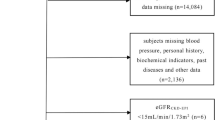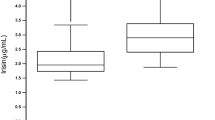Abstract
Some evidence suggests a relationship between thyroid dysfunction and uric acid (UA) metabolism, but the potential influential role of thyroid hormones on UA metabolism is still debated. This report was designed to evaluate the influential role of levothyroxine (L-T4) replacement therapy on circulating levels of UA in patients with recent onset post-thyroidectomy subclinical hypothyroidism. Circulating levels of thyroid hormones, UA and other metabolic parameters were assessed in 155 recently thyroidectomized patients (131 females, mean age 51.1 ± 12.7 years) at baseline (5–7 day after surgery) and after 2 months under replacement therapy with L-T4. At baseline, circulating levels of thyroid hormones were indicative of a subclinical hypothyroidism (TSH 8.2 ± 5.1 mU/mL, FT3 2.1 ± 0.7 pg/mL, FT4 9.2 ± 3.4 pg/mL). The mean serum UA concentration was 5.0 ± 1.3 mg/dL, while the prevalence of hyperuricemia, defined by serum UA levels > 6 mg/dL, was 22.6%. Serum UA levels at baseline were significantly correlated with HOMA-IR index (r = 0.475, p < 0.0001). After 2 months under the replacement therapy with L-T4, both serum UA levels (− 1.2 ± 0.9 mg/dL, p < 0.0001 vs. baseline) and HOMA-IR (− 0.3 ± 1.5 mmol/L, p = 0.0328 vs. baseline) significantly decreased. Multivariate regression analysis revealed that changes in HOMA-IR explained 23% of the variations of serum UA levels under L-T4 replacement therapy (β = 0.295, p < 0.0001, R2 = 0.230). Our study suggests that thyroid hormones could modulate UA metabolism in patients with recent onset subclinical hypothyroidism likely by improving insulin sensitivity.

Similar content being viewed by others

References
Maiuolo J, Oppedisano F, Gratteri S, Muscoli C, Mollace V (2016) Regulation of uric acid metabolism and excretion. Int J Cardiol 213:8–14
Desideri G, Castaldo G, Lombardi A, Mussap M, Testa A, Pontremoli R, Punzi L, Borghi C (2014) Is it time to revise the normal range of serum uric acid levels? Eur Rev Med Pharmacol Sci 18(9):1295–1306
Feig DI, Kang DH, Johnson RJ (2008) Uric acid and cardiovascular risk. N Engl J Med 359:1811–1821
Viazzi F, Leoncini G, Vercelli M, Deferrari G, Pontremoli R (2011) Serum uric acid levels predict new-onset type 2 diabetes in hospitalized patients with primary hypertension: the MAGIC study. Diabetes Care 34(1):126–128
Borghi C, Rosei EA, Bardin T, Dawson J, Dominiczak A, Kielstein JT, Manolis AJ, Perez-Ruiz F, Mancia G (2015) Serum uric acid and the risk of cardiovascular and renal disease. J Hypertens 33(9):1729–1741
Manzato E (2007) Uric acid: an old actor for a new role. Intern Emerg Med 2(1):1–2
Kuzell WC, Schaffarzick RW, Naugler WE, Koets P, Mankle EA, Brown B, Champlin B (1955) Some observations on 520 gouty patients. J Chronic Dis 2:645–669
Kuhlback B (1957) Creatine and creatinine metabolism in thyrotoxicosis and hypothyroidism; a clinical study. Acta Med Scand Suppl 331:1–70
Erickson AR, Enzenauer RJ, Nordstrom DM, Merenich JA (1994) The prevalence of hypothyroidism in gout. Am J Med 97:231–234
Montenegro J, Gonzalez O, Saracho R, Aguirre R, Gonzalez O, Martinez I (1996) Changes in renal function in primary hypothyroidism. Am J Kidney Dis 27:195–198
Bland JH, Frymoyer JW (1970) Rheumatic syndromes of myxedema. N Engl J Med 282:1171–1174
Giordano N, Santacroce C, Mattii G, Geraci S, Amendola A, Gennari C (2001) Hyperuricemia and gout in thyroid endocrine disorders. Clin Exp Rheumatol 19:661–665
Ashizawa K, Imaizumi M, Usa T, Tominaga T, Sera N, Hida A, Ejima E, Neriishi K, Soda M, Ichimaru S, Nakashima E, Fujiwara S, Maeda R, Nagataki S, Eguchi K, Akahoshi M (2010) Metabolic cardiovascular disease risk factors and their clustering in subclinical hypothyroidism. Clin Endocrinol 72:689–695
Raber W, Vukovich T, Vierhapper H (1999) Serum uric acid concentration and thyroid-stimulating-hormone (TSH): results of screening for hyperuricaemia in 2359 consecutive patients with various degrees of thyroid dysfunction. Wien Klin Wochenschr 111:326–328
Ye Y, Gai X, Xie H, Jiao L, Zhang S (2015) Association between serum free thyroxine (FT4) and uric acid levels in populations without overt thyroid dysfunction. Ann Clin Lab Sci 45(1):49–53
Lombardi CP, Bocale R, Barini A, Barini A, D’Amore A, Boscherini M, Bellantone R (2017) Comparative study between the effects of replacement therapy with liquid and tablet formulations of levothyroxine on mood states, self-perceived psychological well-being and thyroid hormone profile in recently thyroidectomized patients. Endocrine 55(1):51–59
Boyle JA, Greig W, Duncan AM, Boyle IT, Buchanan WW (1996) Serum uric acid values in various states of thyroid function. Acta Rheum Scand 12:204–209
Mooraki A, Bastani B (1998) Reversible renal insufficiency, hyperuricemia and gouty arthritis in a case of hypothyroidism. Clin Nephrol 49(1):59–61
Makino Y, Fujii T, Kuroda S, Inenaga T, Kawano Y, Takishita S (2000) Exacerbation of renal failure due to hypothyroidism in a patient with ischemic nephropathy. Nephron 84(3):267–269
Katz AI, Emmanouel DS, Lindheimer MD (1975) Thyroid hormone and the kidney. Nephron 15(3–5):223–249
Ladenson PW (1990) Recognition and management of cardiovascular disease related to thyroid dysfunction. Am J Med 88(6):638–641
Steiger MJ, Watson AR, Morgan AG (1991) Hypothyroidism and renal impairment. J R Soc Med 84(11):688–689
McLaughlin KJ, Mactier RA (1994) Renal impairment in hypothyroidism. Nephrol Dial Transplant 9(10):1521–1522
Maesaka JK, Fishbane S (1998) Regulation of renal urate excretion: a critical review. Am J Kidney Dis 32:917–933
Levinson DJ, Sorensen LB (1980) Renal handling of uric acid in normal and gouty subject: evidence for a 4-component system. Ann Rheum Dis 39:173–179
Gutman AB, Yu T-F (1957) Renal function in gout. With a commentary on the renal regulation of urate excretion, and the role of the kidney in the pathogenesis of gout. Am J Med 23:600–622
Perez-Ruiz F, Aniel-Quiroga MA, Herrero-Beites AM, Chinchilla SP, Erauskin GG, Merriman T (2015) Renal clearance of uric acid is linked to insulin resistance and lower excretion of sodium in gout patients. Rheumatol Int 35(9):1519–1524
Toyoki D, Shibata S, Kuribayashi-Okuma E, Xu N, Ishizawa K, Hosoyamada M, Uchida S (2017) Insulin stimulates uric acid reabsorption via regulating urate transporter 1 and ATP-binding cassette subfamily G member 2. Am J Physiol Renal Physiol 313(3):F826–F834
Kanbay M, Jensen T, Solak Y, Le M, Roncal-Jimenez C, Rivard C, Lanaspa MA, Nakagawa T, Johnson RJ (2016) Uric acid in metabolic syndrome: from an innocent bystander to a central player. Eur J Intern Med 29:3–8
Krishnan E, Pandya BJ, Chung L, Hariri A, Dabbous O (2012) Hyperuricemia in young adults and risk of insulin resistance, prediabetes, and diabetes: a 15-year follow-up study. Am J Epidemiol 176(2):108–116
Author information
Authors and Affiliations
Corresponding author
Ethics declarations
Conflict of interest
The authors declare that they have no conflict of interest.
Statement of human and animal rights
All procedures performed in this study involving human participants were in accordance with the ethical standards of the institutional and/or national research committee and with the 1964 Helsinki declaration and its later amendments or comparable ethical standards.
Informed consent
Informed consent was obtained from all individual participants included in the study.
Additional information
Publisher's Note
Springer Nature remains neutral with regard to jurisdictional claims in published maps and institutional affiliations.
Rights and permissions
About this article
Cite this article
Desideri, G., Bocale, R., D’Amore, A.M. et al. Thyroid hormones modulate uric acid metabolism in patients with recent onset subclinical hypothyroidism by improving insulin sensitivity. Intern Emerg Med 15, 67–71 (2020). https://doi.org/10.1007/s11739-019-02065-9
Received:
Accepted:
Published:
Issue Date:
DOI: https://doi.org/10.1007/s11739-019-02065-9



